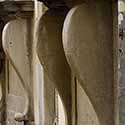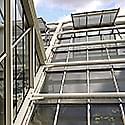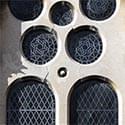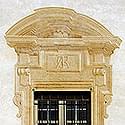
painted surround, an architrave or other enrichment depicted solely in paint, often trompe–l’oeil, on a flat surface.
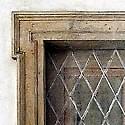
painted window, a trompe–l’oeil window including a surround or an architrave, all depicted in paint on a flat surface.
See also false window.
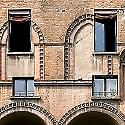
palimpsest, a parchment or other document from which the original script has been erased and replaced by later writing [Latin (by way of Greek): palimpsestus, scraped again].
The term occurs in many disciplines; in this case it is used to draw attention to separate layers of history in the façade of a building. At least three periods of occupation can be seen in this example, in which later modern windows have been superimposed on the original pointed–arched blocked–up windows in a startlingly uncompromising fashion, presumably in the name of ‘honesty’.
Palladian window, see Serliana.
pane, a sheet of glass held in glazing bars or a frame, forming part of a light or window.
A pane of glass in a metal framework was one stage up from oiled linen stretched across a rough lattice. A wooden frame holding several panes was another stage, the ultimate leap being one large uninterrupted pane, which was not generally affordable until the middle of the nineteenth century. Royalty could command the latest technology, and Louis XIV set the pace at the Palace of Versailles, inspiring Wren after his visit in 1665 to follow suit and ensure that Hampton Court Palace would have some of the largest panes of glass in England at that time. The panes of glass in the windows under the pediment measure 29½ inches by 21½ inches (75 cm x 55 cm).
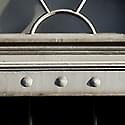
patera, a saucer–like Classical ornament, used to enliven plain surfaces [Latin: patera, a flat dish or saucer, used especially in offerings to the Gods].
In this illustration a series of paterae create interest on the plain surface of the blind box. The ornamented band over the window is a guilloche (which see).
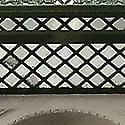
pavement–light, solid glass blocks set in a cast iron or reinforced concrete frame.
Its principal application was in the lighting of basements that extended into the area occupied by pavements, but it found other uses, particularly in maximising lighting levels in interior spaces served by balconies.

pediment, a low pitched triangular gable form with raking copings enclosing a triangular tympanum.
The Latin pedamentum indicates a stake or prop for supporting vines or trees, and the French use fronton for pediment, so where does the word pediment come from? The Oxford English Dictionary, after a couple of aborted attempts to trace its origins, comes down in favour of the notion that pediment is a corruption of periment, which in turn is itself a workman’s mispronunciation of pyramid, which a pediment resembles in some sense. John Evelyn, the writer and diarist records in 1664 the use of the word pedament, but was probably referring to usage in or around London. The O.E.D. quotes a source claiming that the word for a ‘triangular gable . . . is actually pronounced periment or purriment by the illiterate in some districts of England . . . at the present day (1904)’.
peep–hole, an aperture in a door or wall.
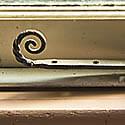
peg stay, a device for securing a side–hung casement window.
Used in conjunction with a cockspur fastener or similar security device fixed to the jambs of the casement. Security is improved slightly if two pins or pegs are provided, one at each end of the stay.
persienne, see plantation shutters [French: persienne, slatted shutter].
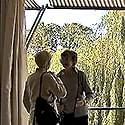
picture–window, a large window, fixed or otherwise, containing a single sheet of glass.
The eighteenth century architect Isaac Ware would have approved of picture windows. He famously said “as much glass should be seen, and as nearly a continued body as possible”, meaning without the interruption of glazing bars. This was not achieved until the middle of the nineteenth century, when plate glass became widely available. From that time onward sash windows could be adapted to take clear glass in the bottom sash, thereby creating a modest form of picture window. By the end of the nineteenth century giant shop windows had become the norm throughout Europe and a new breed of architects realised that these could be used in a domestic setting. The illustration shows a house built in 1928–30 in what is now the Czech Republic, designed by Lugwig Mies van der Rohe. One wall of this room is entirely of glass, which can be made to disappear into the floor. (Hitler’s architect Albert Speer records in his autobiography Inside the Third Reich, 1970, that Hitler himself copied the idea but because he located the window over a garage escaping petrol fumes prevented its regular use). The idea of ‘bringing the outside in’ reached America, perhaps as a result of German architects escaping from the pressure of Nazi politics. In the 1940s a new American craze for picture windows flourished. Publications such as Tomorrow’s House and American Home brought the concept back across the Atlantic to Britain. Here it blossomed in the 1960s as the ubiquitous sliding patio door. In Angus Wilson’s novel Late Call, 1963, retired hotel manager Sylvia Calvert is moving in with her overbearing New Town headmaster son, Harold Calvert. He points out the main architectural features of his detached house ‘The Sycamores’ — ‘ “Ashlar blocks, you see, give it strength. And the white weather–boarding preserves the local character. I’m all for picture windows, aren’t you Mother?” Sylvia didn’t really know what to say about it — parts looked quite pretty and old–fashioned like a farmhouse, and other parts looked quite light and airy and modern. “Its very unique, isn’t it, Harold?” — “It’s a ranch–type house, he said. After all, if the New Towns have done nothing else they’ve taught us the one valuable lesson the famous American way of life has to offer . . .” ’
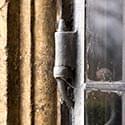
pintle hinge, an early form of lift–off casement window hinge consisting of a pintle fixed to the outside frame and a gudgeon fixed to the outside of the casement.
It will be obvious that early casements, always outward opening, would have tended to disappear overnight were it not for the cockspur fastener, which once applied keeps the window firmly immobilised. The luxury and security of external shutters was unavailable until the introduction of the sash window. The pintle hinge appears in a number of guises, from domestic, commercial and agricultural gates to a variety of marine applications.
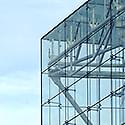
planar glazing, Pilkington’s proprietary structural glazing system [Latin: planaris, on a level surface, flat].
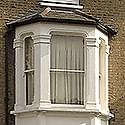
plate–glass, a strong type of high–quality clear glass, available in large sheets from the early nineteenth century onwards [French: plat, plate, flat].
Until the 1780s cast–plate glass had to be imported from France. Improved availability in Britain was due to both advances in manufacturing techniques and the lifting of excise duty on certain kinds of glass in the middle of the nineteenth century. Windows were often re–sashed using plate–glass (see picture window). The additional weight led to failures at the bottom corners of top sashes, as the mortice–and–tenon joint was often too weak. The problem was overcome by introducing ‘horns’ to strengthen the corners. In this late nineteenth house the sashes would have been fitted with plate–glass from the beginning; interestingly, the central windows have been treated differently, having a pattern of semi–obscured and coloured glass — allowing a degree of privacy to what we can assume to be a central staircase.
pointed arch, a shape formed by two arcs springing from centres outside the jamb of the opening (lancet arch); or at the springing of the arch (equilateral arch); or within the jambs (drop arch).
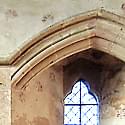
pointed segmental arch, an arch formed of two segmental arches, the centre–points of each of which are either side of the centreline.
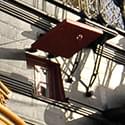
port–hole, an aperture in the hull of a ship [Latin: porta, gate, door].
Fighting ships were provided with gun–ports, another French invention according the Naval Chronicles, 1802, which tell us that ‘the contrivance of port–holes . . . is attributed to Descharges, a French ship–builder at Brest, in the reign of Louis the Twelfth’ (1462–1515). By 1691 they appear in ‘An Account of Several New Inventions and Improvements . . . relating to Building our English Shipping’. The 104 gun–ports of HMS Victory, launched 1765, were closed with cannon–ball–resistant square top hung outward–opening external doors operated by ropes from within the hull. Inset is a detail from a painting showing Admiral Rodney’s flagship Sandwich (launched 1759) under attack during the American War of Independence, showing that the bottom window sashes were also raised or removed during battle. Port–holes became predominantly round once the circumstances were such that they no longer necessarily needed to open.
purdah, parda, an Anglo–Indian word meaning, literally, a curtain, but most commonly used to mean a curtain screening women from the sight of men.
The Victorian author of Life in the Mofussil (Indian provinces) explained that ‘Native ladies look upon the confinement behind the purdah as a badge of rank, and also as a sign of chastity, and are exceedingly proud of it’. Travelling could be a problem. Fanny Parkes, wife of a British Army Officer (see thermantidote and verandah) records an occasion on which she was invited to take part the wedding of an Indian Princess. After the wedding ‘the young Princess retired to bath . . . after which she rejoined us and we set out to walk half a mile (back) to the tents of the bride; this being part of the ceremony . . . The Gaja Raja, her ladies and attendants . . . and myself, walked with her in parda; that is, the canvas walls of tents having been fixed on long poles so as to form an oblong enclosure, a great number of men on the outside took up the poles and moved gently on; while we who were on the inside walked in procession over white cloths.’ Although ‘purdah women’ were a comparatively small proportion of their sex, it seems that an Indian railway company made special provision for them, as The Times for April 1937 records — ‘In the first class compartment there are four special ventilators and purdah glass louvres above the ventilators. But the word could also refer to a specific type of material — ‘an Indian cotton cloth, with white and blue stripes, used for curtains etc.’ — according to Simmonds Trade Dictionary of that time. It would have been this material that Fanny Parkes employed when she was obliged to set up home in a mountainous area of India where the climate was inhospitable — ‘From my bungalow the view is beautiful, and we have as much air as man can desire. The first thing was to get pardas, stuffed with cotton, for every window and door . . .’ In other words ‘heavy curtains’.



